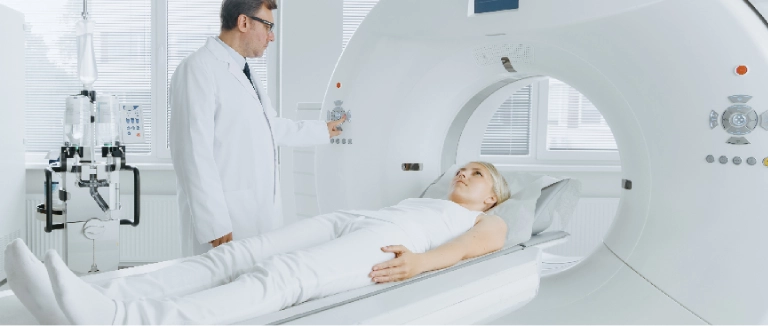Nuclear Medicine
Last Update Date: 9/17/2025 3:27:07 PM
Nuclear medicine is a field of medicine in which radioactive materials are used and includes various medical imaging and treatment procedures.
What is Nuclear Medicine
Nuclear medicine is a field of medicine in which radioactive materials are used and includes various medical imaging and treatment procedures. This technology uses the introduction of radioactive substances called isotopes into the body and focusing these substances on certain organs or tissues by emitting radiation.
Nuclear medicine, a branch of medicine in which radioactive substances are used in the diagnosis and treatment of diseases, has an important place especially in the diagnosis, treatment and follow-up of oncological diseases with its applications in which functional and structural evaluation can be performed simultaneously.
Which Diseases Does Nuclear Medicine Treat
Nuclear medicine encompasses a medical field used for the diagnosis, treatment and follow-up of various diseases. Here are some diseases that nuclear medicine focuses on:
Cancer: Nuclear medicine is used for cancer diagnosis, evaluation of metastasis, and treatment of some types of cancer. Cancer cells can be identified using radioactive isotopes and monitored to follow up the response to treatment.
Thyroid Diseases: Nuclear medicine is used to evaluate the functions of the thyroid gland and determine thyroid nodules. Thyroid scintigraphy and radioactive iodine therapy are widely used applications for the diagnosis and treatment of thyroid diseases.
Bone Diseases: Nuclear medicine is used for the evaluation of bone structures with methods such as bone scintigraphy. Bone scans can be used for diagnosis and evaluation of bone metastases, infections or traumas.
Cardiovascular Diseases: Myocardial scintigraphy is a nuclear medicine method used for the evaluation of coronary artery disease. With this method, the blood flow and perfusion of the heart muscle are examined.
Lung Diseases: Lung perfusion scintigraphy and lung ventilation scintigraphy can be used for the evaluation of lung function and the diagnosis of pulmonary embolism.
Neurological Diseases: Nuclear medicine can help in the evaluation and determination of neurological diseases such as Alzheimer's disease, Parkinson's disease and epilepsy.
Liv Hospital Nuclear Medicine
As in many other areas within Liv Hospital, a safe and effective service is provided in the Nuclear Medicine unit with competent personnel and state-of-the-art devices.
Methods in the unit in this field:
They are sensitive and purpose-specific methods. There are no allergies and side effects. They provide functional information at the physiological, metabolic level. Since the information is also numerical, it can be compared with each other when repeated. Due to their non-invasive nature, they do not cause discomfort and harm to the patient. In Nuclear medicine applications, the patient receives very low levels of radiation.
Diagnostic Tests:
- PET/CT
- Gamma Camera
- C14 Device (Survey Meter)
- Gamma Probe
- Gamma counter Hot Lab (Department where radioactive materials are prepared) Effort test unit There are outpatient clinic units.
In the inpatient treatment unit;
- Treatment applications other than radioactive iodine
- Radioactive iodine applications (Two lead lined rooms)
- Radioactive material application and preparation unit are available.
Nuclear Medicine and Molecular Imaging Clinic Imaging Procedures
Imaging procedures at the Nuclear Medicine and Molecular Imaging Clinic are performed with devices called gamma camera or PET\CT depending on the type of radiation emitted by the radioactive substance used. With the existing devices, the diagnosis of diseases belonging to all organs and systems is ensured and treatment can be managed. The functions of many organs and systems are evaluated.
Radioactive substance applications are performed for therapeutic purposes in some tumors, painful bone metastases, inflammatory joint diseases and especially thyroid diseases.
Do I need preliminary preparation before the examination?
Preliminary preparation is required for some examinations in the Department of Nuclear Medicine. Information about how you should prepare for these examinations when arriving on the appointment day is made both verbally and in a written form.
How are radioactive substances used for diagnosis?
In the Department of Nuclear Medicine, examinations are performed by giving a low dose of radioactive material to the patient either intravenously or orally.
How long is the estimated waiting time before imaging?
After the injection, it is necessary to wait for a certain period of time for the given substance to be able to spread sufficiently throughout the body. The waiting time varies depending on the examination to be performed.
How is imaging performed in Nuclear Medicine?
Imaging is done with devices called Gamma Camera or PET-CT. The four sides of the devices are open and the imaging time varies according to the test.
How often can nuclear medicine tests be performed?
In cases where the desired result cannot be achieved, when it is necessary to repeat the same examination, or in cases where several nuclear medicine examinations must be performed consecutively, scintigraphy can be performed at intervals of 2-3 days.
Are the radioactive materials used harmful?
In nuclear medicine applications, patients are exposed to very low levels of radiation. Applied radiopharmaceuticals are radioactive substances with low radiation and short life, and they do not accumulate in the body. They are excreted from the body by urine, sweat and intestines, as well as getting reduced by physical halving on their own. These substances can be safely administered to patients and children of all ages with doses determined according to their age and weight.
Should I stay away from people after the examination?
Since the amounts of radioactive substances used in the examinations are at very low levels, there is no need to stay away from people in general. However, it is recommended to stay away from children and pregnant women as a precautionary measure for 24 hours after the injection.

















.webp)



